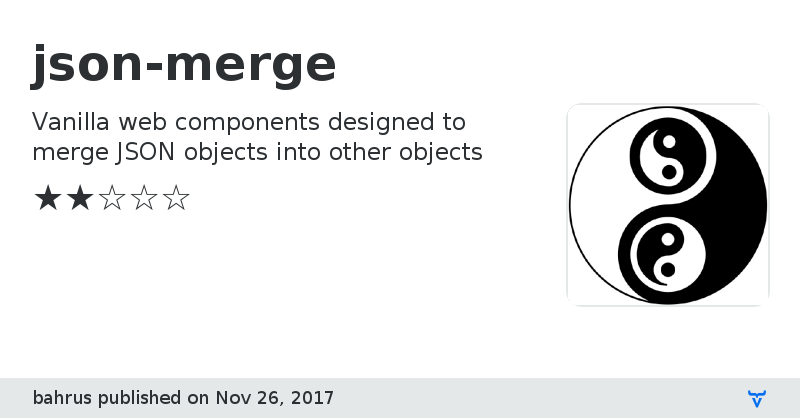json-merge - Vaadin Add-on Directory
Vanilla web components designed to merge JSON objects into other objects
 # \
# \Issue tracker
License
View on GitHub
View on NPM
Online Demo
json-merge version 0.0.0
### Dependencies
Polymer/polymer#^2.0.0
json-merge version 0.0.1
### Dependencies
Polymer/polymer#^2.0.0
* bahrus/poly-prep#^0.0.5
json-merge version 0.0.2
### Dependencies
Polymer/polymer#^2.0.0
* bahrus/poly-prep#^0.0.5
json-merge version 0.0.3
### Dependencies
Polymer/polymer#^2.0.0
* bahrus/poly-prep#^0.0.5
json-merge version 0.0.4
### Dependencies
Polymer/polymer#^2.0.0
json-merge version 0.0.5
### Dependencies
Polymer/polymer#^2.0.0
json-merge version 0.0.6
### Dependencies
Polymer/polymer#^2.0.0
json-merge version 0.0.7
### Dependencies
Polymer/polymer#^2.0.0
* bahrus/xtal-json-editor#^0.0.6
json-merge version 0.0.8
### Dependencies
Polymer/polymer#^2.0.0
* bahrus/xtal-json-editor#^0.0.6
json-merge version 0.0.9
### Dependencies
Polymer/polymer#^2.0.0
* bahrus/xtal-json-editor#^0.0.6
json-merge version 0.0.10
### Dependencies
Polymer/polymer#^2.0.0
* bahrus/xtal-json-editor#^0.0.6
json-merge version 0.1.0
### Dependencies
* @bower_components/accessibility-developer-tools#GoogleChrome/accessibility-developer-tools#^2.10.0
* @bower_components/async#caolan/async#^1.5.0
* @bower_components/chai#chaijs/chai#^3.2.0
* @bower_components/font-roboto#PolymerElements/font-roboto#^1
* @bower_components/iron-demo-helpers#PolymerElements/iron-demo-helpers#^2.0.0
* @bower_components/iron-flex-layout#polymerelements/iron-flex-layout#1 - 2
* @bower_components/iron-location#PolymerElements/iron-location#1 - 2
* @bower_components/lodash#lodash/lodash#^3.7.0
* @bower_components/marked#chjj/marked#~0.3.6
* @bower_components/marked-element#polymerelements/marked-element#1 - 2
* @bower_components/mocha#mochajs/mocha#^3.1.2
* @bower_components/polymer#Polymer/polymer#^2.0.0
* @bower_components/prism#LeaVerou/prism#*
* @bower_components/prism-element#PolymerElements/prism-element#1 - 2
* @bower_components/shadycss#webcomponents/shadycss#^v1.0.0
* @bower_components/sinon-chai#domenic/sinon-chai#^2.7.0
* @bower_components/sinonjs#blittle/sinon.js#^1.14.1
* @bower_components/stacky#PolymerLabs/stacky#^1.3.0
* @bower_components/test-fixture#PolymerElements/test-fixture#^3.0.0
* @bower_components/web-component-tester#Polymer/web-component-tester#^6.0.0
* @bower_components/webcomponentsjs#webcomponents/webcomponentsjs#^1.0.0
* @bower_components/xtal-json-editor#bahrus/xtal-json-editor#^0.0.6
json-merge version 0.1.1
### Dependencies
* @bower_components/accessibility-developer-tools#GoogleChrome/accessibility-developer-tools#^2.10.0
* @bower_components/async#caolan/async#^1.5.0
* @bower_components/chai#chaijs/chai#^3.2.0
* @bower_components/font-roboto#PolymerElements/font-roboto#^1
* @bower_components/iron-demo-helpers#PolymerElements/iron-demo-helpers#^2.0.0
* @bower_components/iron-flex-layout#polymerelements/iron-flex-layout#1 - 2
* @bower_components/iron-location#PolymerElements/iron-location#1 - 2
* @bower_components/lodash#lodash/lodash#^3.7.0
* @bower_components/marked#chjj/marked#~0.3.6
* @bower_components/marked-element#polymerelements/marked-element#1 - 2
* @bower_components/mocha#mochajs/mocha#^3.1.2
* @bower_components/polymer#Polymer/polymer#^2.0.0
* @bower_components/prism#LeaVerou/prism#*
* @bower_components/prism-element#PolymerElements/prism-element#1 - 2
* @bower_components/shadycss#webcomponents/shadycss#^v1.0.0
* @bower_components/sinon-chai#domenic/sinon-chai#^2.7.0
* @bower_components/sinonjs#blittle/sinon.js#^1.14.1
* @bower_components/stacky#PolymerLabs/stacky#^1.3.0
* @bower_components/test-fixture#PolymerElements/test-fixture#^3.0.0
* @bower_components/web-component-tester#Polymer/web-component-tester#^6.0.0
* @bower_components/webcomponentsjs#webcomponents/webcomponentsjs#^1.0.0
* @bower_components/xtal-json-editor#bahrus/xtal-json-editor#^0.0.6
json-merge version 0.1.2
### Dependencies
Polymer/polymer#^2.0.0
json-merge version 0.1.3
### Dependencies
Polymer/polymer#^2.0.0
json-merge version 0.1.4
### Dependencies
Polymer/polymer#^2.0.0
json-merge version 0.2.1
### Dependencies
* @polymer/polymer#^3.0.0
json-merge version 0.2.2
### Dependencies
* @polymer/polymer#^3.0.0
json-merge version 0.2.4
### Dependencies
* @polymer/polymer#^3.0.0
* jiife#^0.0.0
json-merge version 0.2.5
### Dependencies
* @polymer/polymer#^3.0.0
* jiife#^0.0.0
json-merge version 0.2.6
### Dependencies
* @polymer/polymer#^3.0.0
* jiife#^0.0.0
json-merge version 0.2.7
### Dependencies
* @polymer/polymer#^3.0.0
* jiife#^0.0.0
json-merge version 0.2.8
### Dependencies
* @polymer/polymer#^3.0.0
* jiife#^0.0.0
json-merge version 0.2.9
### Dependencies
* @polymer/polymer#^3.0.0
* jiife#^0.0.0
json-merge version 0.2.10
### Dependencies
* @polymer/polymer#^3.0.0
* jiife#^0.0.0
json-merge version 0.2.11
### Dependencies
* @polymer/polymer#^3.0.0
* jiife#^0.0.0
json-merge version 0.2.12
### Dependencies
* @polymer/polymer#^3.0.0
* jiife#^0.0.0
json-merge version 0.2.13
### Dependencies
* @polymer/polymer#^3.0.0
* jiife#^0.0.0
json-merge version 0.2.14
### Dependencies
* @polymer/polymer#^3.0.0
* jiife#^0.0.0
* xtal-latx#^0.0.2
json-merge version 0.2.15
### Dependencies
* @polymer/polymer#^3.0.0
* jiife#^0.0.0
* xtal-latx#^0.0.5
json-merge version 0.2.16
### Dependencies
* @polymer/polymer#^3.0.0
* jiife#^0.0.0
* xtal-latx#^0.0.10
json-merge version 0.2.17
### Dependencies
* @polymer/polymer#^3.0.0
* jiife#^0.0.0
* xtal-latx#^0.0.11
json-merge version 0.2.18
### Dependencies
* @polymer/polymer#^3.0.0
* jiife#^0.0.0
* xtal-latx#^0.0.11
json-merge version 0.2.19
### Dependencies
* @polymer/polymer#^3.0.0
* jiife#^0.0.0
* xtal-latx#^0.0.11
json-merge version 0.2.20
### Dependencies
* @polymer/polymer#^3.0.0
* xtal-latx#^0.0.11
json-merge version 0.2.21
### Dependencies
* @polymer/polymer#^3.0.0
* xtal-latx#^0.0.11
json-merge version 0.2.22
### Dependencies
* @polymer/polymer#^3.0.0
* xtal-latx#^0.0.11
json-merge version 0.2.23
### Dependencies
* @polymer/polymer#^3.0.0
* xtal-latx#^0.0.11
json-merge version 0.2.24
### Dependencies
* xtal-latx#^0.0.17
json-merge version 0.2.25
### Dependencies
* xtal-latx#0.0.17
json-merge version 0.2.26
### Dependencies
* xtal-latx#0.0.17
json-merge version 0.2.27
### Dependencies
* xtal-latx#0.0.18
json-merge version 0.2.28
### Dependencies
* xtal-latx#0.0.19
json-merge version 0.2.29
### Dependencies
* xtal-latx#0.0.42
json-merge version 0.2.30
### Dependencies
* xtal-latx#0.0.42
json-merge version 0.2.31
### Dependencies
* xtal-latx#0.0.42
json-merge version 0.2.32
### Dependencies
* xtal-latx#0.0.42
json-merge version 0.2.33
### Dependencies
* xtal-element#0.0.43
json-merge version 0.2.34
### Dependencies
* xtal-element#0.0.43
json-merge version 0.2.35
### Dependencies
* xtal-element#0.0.58
* trans-render#0.0.110